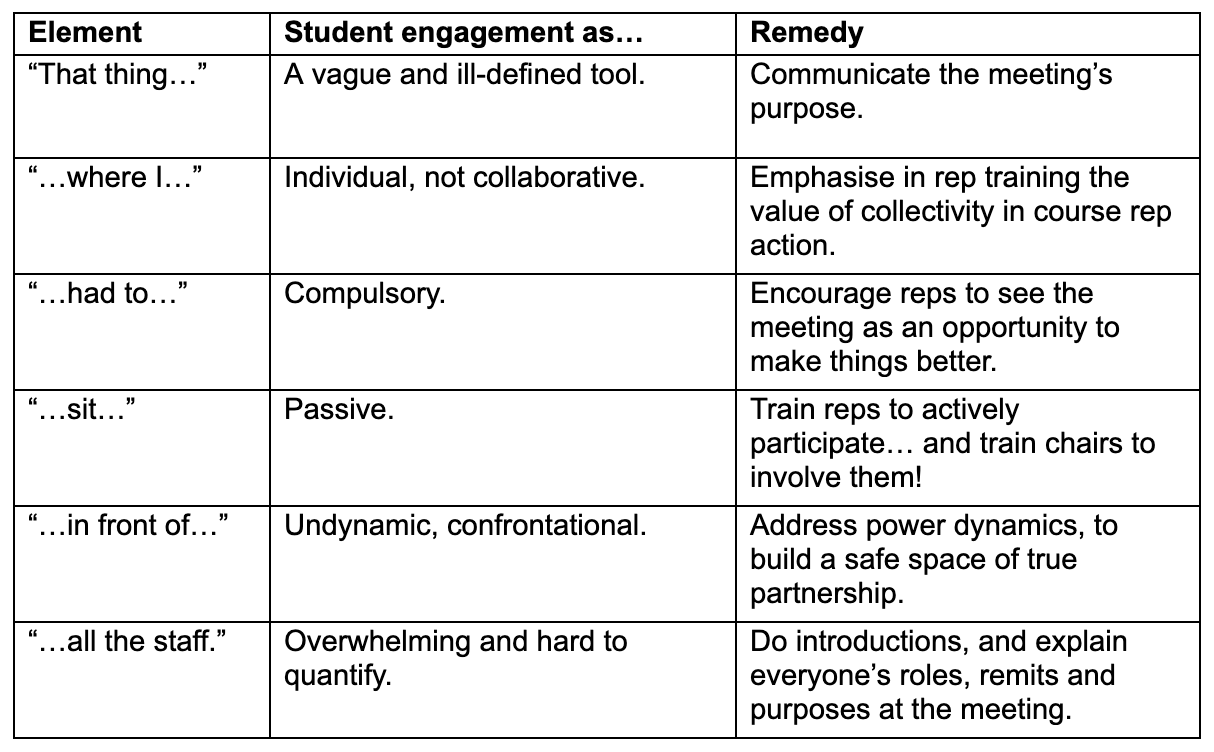Many years ago, I helped an institution to run workshops to learn from course reps about their experiences.
One session involved gathering feedback about course committees – where reps would meet with their teaching staff to discuss ideas for enhancement.
We asked whether people had in fact attended a course committee and everyone raised a hand – except one young woman.
She looked briefly confused, until the person sitting next to her nudged her and said something, whereupon she declared:
Oh yeah, that thing where I had to sit in front of all the staff.
It was a striking statement, revealing the gap between the perception and reality of the course committee meeting’s purpose.
Over the years I’ve often mulled it over, and in moving from a sector role to a students’ association post about a year ago I’ve begun to crystalise my thoughts about the tremendous power her words had – not because it showed her ignorance about the meeting, but because of the huge truth it perhaps unintentionally illustrated about student engagement in quality.
Indeed, I find rich meaning in just about every single word she used.
That thing…
When we describe an object or experience as a “thing”, it suggests we are not sure or are unable explain exactly what it is.
That the rep didn’t even instinctively call it an event, discussion or meeting means she presumably had no appreciation of its function or her purpose within it.
While we might imagine most staff would have understood their role at the meeting and what indeed the gathering was for, to our rep it was merely a “thing”.
…where I…
She spoke in the first person singular. Her experience was individual, isolated… and maybe isolating. While course committees generally include reps from across a course or programme, and other students might have attended the meeting in question, they were not a part of our rep’s recollection of it.
Instead of a collaborative process where reps share their views of learning and build something together, our speaker here was by herself – an “I”.
…had to…
We all sometimes complain about committees, but ideally all participants should have a stake in what is happening and see them as a way of getting things done.
Our rep, however, revealed no sense of opportunity or shared ownership of the meeting, no desire to use it to raise concerns or suggest ideas, and no indication of reward or recognition for attending. It seems it was a just obligation, existing for reasons unclear.
…sit…
There are so many words we could use to describe our place in a productive, worthwhile meeting: participate, join, contribute. That the first verb she reached for was passive, that the main thing she recalled doing in the meeting was sitting, suggests she may not have been a hugely active presence.
Did she talk? Did she listen or learn? Did she present, debate or explore ideas in a rich discussion with staff? Did she help to draw conclusions or identify actions? Did she leave the room knowing that something would change in the learning experience?
We don’t know. All we know is that she sat.
…in front of…
The physical dynamic of a meeting, especially in-person, is important. Who sits where, who can see who, and how the chair involves everyone, can all influence the flow and inclusivity of discussions.
We might imagine that in a good course committee meeting student reps might sit together, or that students unsure of their role might have a friendly lecturer close by to help answer questions or detect their signs of confusion.
In contrast, to sit “in front of” someone suggests a power dynamic like a job interview or a presentation, or worse a confrontation or interrogation.
…all the staff.
Our rep finishes as she starts – with vagueness. There’s some truth to her description, because indeed many staff do attend course committee meetings – the academics, and perhaps colleagues from quality, student support or learning services.
But “all the staff” suggests a homogenous group, with nothing revealed about specifically who was there and why their presence might be important or valuable for student reps in the room.
Lessons for partnership
All that said, I don’t want to dwell on the negatives. Despite her uncertainty, this young woman took on the role of course rep, attended that course committee meeting, then came along to my workshop. That’s got to count for something.
Thinking back, I wish I’d gently pressed the rep on her words, to ask her what could have made things better, whether there were lessons for future course committee meetings.
Mind you, even without that hindsight, it is still easy to take some lessons from what she said.
For each powerful revelation in our rep’s statement, there is a corresponding action we can consider:

As I reflect on these potential actions that could improve course level student engagement within my institution, it’s worth noting the recent publication of a new resource from my old employer, sparqs – Scotland’s Ambition for Student Partnership.
It’s a helpful document with suggested features and indicators of partnership in quality, relating to everything from training to communication, and from resources to structures.
While its roots lie in the strengthened voice for students in Scotland’s new Tertiary Quality Enhancement Framework, for me its applicability lies in those everyday conversations staff can have with students and course reps about their experiences – even if what reps say at first might sound like a failure.












